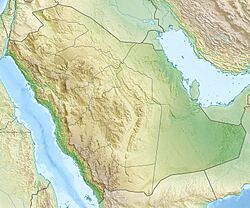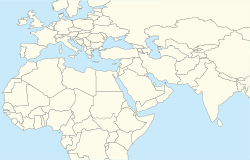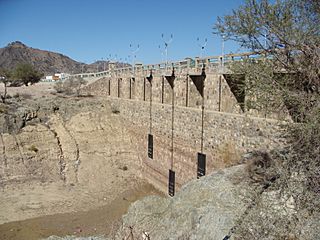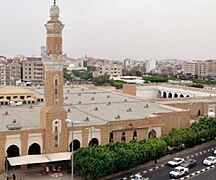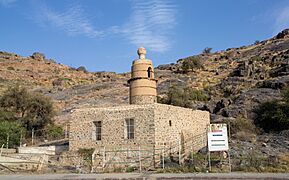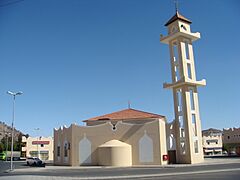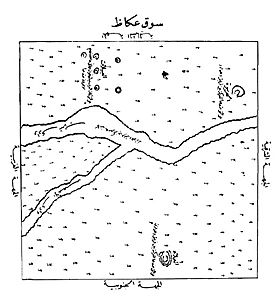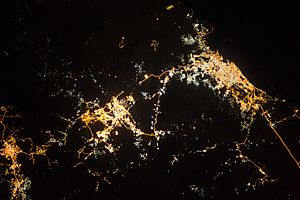Taif facts for kids
Quick facts for kids
Taif
Aṭ-Ṭāʾif (ٱلطَّائِف)
|
|
|---|---|
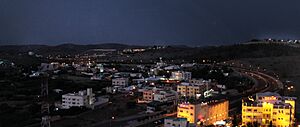
Taif, as seen from Al Hada
|
|
| Nickname(s):
Madīnat al-Wurūd (مَدِيْنَة ٱلْوُرُوْد)
Summer capital of the Kingdom |
|
| Country | |
| Province | Makkah |
| Governorate | Taif |
| Area | |
| • City | 321 km2 (124 sq mi) |
| Elevation | 1,879 m (6,165 ft) |
| Population
(2022 census)
|
|
| • City | 563,282 |
| • Rank | 6 |
| • Density | 2,144/km2 (5,554/sq mi) |
| • Metro | 913,374 (Taif Governorate) |
| Demonym(s) | Taifian |
| Time zone | UTC+3 (GMT + 3) |
| Postal Code |
26XXX
|
| Area code(s) | +966 12 |
| Website | http://www.taifcity.gov.sa |
Taif (Arabic: اَلطَّائِفُ, romanized: Aṭ-Ṭāʾif, lit. 'The circulated or encircled') is a big city in the Makkah Province of Saudi Arabia. It is located high up in the Hijaz Mountains, about 1,879 meters (6,165 feet) above sea level. In 2022, over 563,000 people lived there, making it one of Saudi Arabia's largest cities.
Taif is sometimes called the unofficial "summer capital" of Saudi Arabia. This is because it has much cooler weather in summer compared to most of the Arabian Peninsula. Many people visit Taif for its mountain resorts and pleasant climate. The city is also known for its farms, growing grapes, pomegranates, figs, and roses. It's even called "City of the Roses" (Madīnat al-Wurūd) because it makes famous rose oil. Taif is also home to the historic Souq 'Okaz, a very old market.
The city is divided into five smaller areas: North, West, East, South, and New Taif. It has its own airport, Taif International Airport, with plans for a bigger one by 2030.
Contents
What's in a Name?
Like many cities in the Hejaz region, Taif had an older name: Wajj. This name also belonged to a famous valley nearby.
The current name, Taif (Arabic: اَلطَّائِفُ), comes from an Arabic word that means "wanderer" or "circulator." It's related to the word Ṭawāf, which means "circling" or "walking around something."
Taif got its name because the Banu Thaqif tribe built a wall that circled the city. So, "Taif" literally means "the circulated" or "encircled city."
A Look Back in Time
In the 500s AD, the Thaqif tribe was in charge of Taif. This tribe still lives in the area today. Taif was an important religious place because it had an idol of a goddess named Lāt.
The city's cool climate made it special compared to the dry areas nearby. Farmers grew wheat, vines, and fruits, which is why Taif was called "the Garden of the Hejaz." Both Taif and Mecca were places people visited for religious reasons. Taif was also a busy trading center.
Early Islamic Times
In the early 600s CE, the Islamic prophet Muhammad visited Taif. He was trying to share the message of Islam, but some people in Taif resisted.
Later, in 630, a battle happened near the city. After that, there was a siege where attackers tried to capture the city using catapults, but Taif fought them off. In 631, the city felt alone, so members of the Thaqif tribe went to Mecca to agree to become Muslim. The idol of Lāt and other old religious symbols were then removed.
After this, Taif's importance became less than that of the holy cities of Mecca and Medina, even though it changed hands many times.
Under Ottoman Rule
In 1517, Taif became part of the Ottoman Empire. It stayed under Ottoman control for about 300 years. But in 1802, rebels connected to the House of Saud took over Taif, and then Mecca and Medina.
This loss was a big deal for the Ottomans. So, the Ottoman leader asked Muhammad Ali, the ruler of Egypt, to get the cities back. Muhammad Ali recaptured Taif in 1813.
A traveler named Johann Ludwig Burckhardt visited Taif in 1813. He saw that much of the city was still in ruins from the earlier battles. He also noted that most of the people living there were still from the Thaqif tribe. Taif was a center for trading coffee at that time.
The Ottomans later repaired the castle and military buildings in Taif in 1843. They also built a government building in 1869 and set up a post office.
The Arab Revolt
Before the Arab Revolt began, Ottoman forces were in Taif. In 1916, the Hashemites started their revolt against the Ottoman Empire in Mecca. After Mecca fell, Abdullah, the son of the Hashemite leader Husayn ibn Ali, came to Taif with his men.
Abdullah secretly built up his army to 5,000 men. He then cut the city's telegraph wires and attacked. The Ottomans fought back with mountain guns, and the city was under siege. But as the Hashemite forces brought in more guns, Taif finally gave up on September 22. The city then became part of the new Kingdom of Hejaz.
Saudi Conquest and Modern Times
Taif did not stay with the Hashemites for long. Conflicts grew between the King of Hejaz and Abdulaziz al-Saud, the ruler of another region. In 1924, a Saudi-supported group called the Ikhwan attacked Taif. The king's son, 'Ali, fled with his soldiers, and many of his men were killed. This event is known as the Ta'if massacre.
In 1926, Abdulaziz al-Saud became the new King of Hejaz. Taif remained part of the Kingdom of Hejaz until Abdulaziz al-Saud united his lands to form the Kingdom of Saudi Arabia in 1932. An important treaty setting the border between Yemen and Saudi Arabia was signed in Taif in 1934. Two Saudi kings, Ibn Saud and King Khalid, later passed away in the city.
When the Saudis took control, Taif was still a very old-fashioned city. But they began to modernize it. Saudi Arabia's first public power generator was set up in Taif in the late 1940s. In 1965, a new mountain highway was opened, connecting Mecca and Taif. This road is now part of Highway 15. By the time of the 1991 Gulf War, Taif was modern enough to be chosen as a communication center for the war effort.
Taif's Location and Climate
The entire Taif area is on a high plateau, surrounded by the Hijaz Mountains to the west and south. The city itself is about 1,879 meters (6,165 feet) above sea level. The mountains around Taif are even taller, reaching up to 3,500 meters (11,483 feet). Taif used to have many valleys with flowing water, and you can still see old dams there. The highest point in Taif, Jabal Daka, is the fifth highest peak in Saudi Arabia.
Weather in Taif
Taif has a hot desert climate, but it's much cooler in summer than other parts of Saudi Arabia, like Riyadh. It doesn't rain much, but some rain falls in most months, especially in spring and late autumn.
| Climate data for Ta'if (1991-2020) | |||||||||||||
|---|---|---|---|---|---|---|---|---|---|---|---|---|---|
| Month | Jan | Feb | Mar | Apr | May | Jun | Jul | Aug | Sep | Oct | Nov | Dec | Year |
| Record high °C (°F) | 32.0 (89.6) |
33.0 (91.4) |
34.0 (93.2) |
35.2 (95.4) |
39.0 (102.2) |
40.2 (104.4) |
41.0 (105.8) |
40.0 (104.0) |
40.0 (104.0) |
36.0 (96.8) |
32.5 (90.5) |
30.0 (86.0) |
41.0 (105.8) |
| Mean daily maximum °C (°F) | 23.1 (73.6) |
25.3 (77.5) |
27.7 (81.9) |
30.6 (87.1) |
33.9 (93.0) |
36.3 (97.3) |
35.6 (96.1) |
36.0 (96.8) |
35.2 (95.4) |
31.1 (88.0) |
26.8 (80.2) |
24.2 (75.6) |
30.5 (86.9) |
| Daily mean °C (°F) | 15.8 (60.4) |
17.7 (63.9) |
20.2 (68.4) |
23.2 (73.8) |
26.5 (79.7) |
29.6 (85.3) |
29.3 (84.7) |
29.5 (85.1) |
28.2 (82.8) |
23.7 (74.7) |
19.6 (67.3) |
16.9 (62.4) |
23.3 (74.0) |
| Mean daily minimum °C (°F) | 8.7 (47.7) |
10.3 (50.5) |
12.8 (55.0) |
16.0 (60.8) |
19.3 (66.7) |
22.8 (73.0) |
23.6 (74.5) |
23.8 (74.8) |
21.0 (69.8) |
16.0 (60.8) |
12.5 (54.5) |
9.8 (49.6) |
16.4 (61.5) |
| Record low °C (°F) | −1.5 (29.3) |
0.0 (32.0) |
0.5 (32.9) |
4.0 (39.2) |
5.6 (42.1) |
13.9 (57.0) |
13.3 (55.9) |
13.3 (55.9) |
11.4 (52.5) |
8.0 (46.4) |
5.0 (41.0) |
−1.0 (30.2) |
−1.5 (29.3) |
| Average precipitation mm (inches) | 9.7 (0.38) |
1.1 (0.04) |
12.4 (0.49) |
34.1 (1.34) |
34.8 (1.37) |
3.8 (0.15) |
2.4 (0.09) |
17.2 (0.68) |
9.1 (0.36) |
16.1 (0.63) |
23.1 (0.91) |
5.0 (0.20) |
168.8 (6.65) |
| Average precipitation days (≥ 0.1 mm) | 1.2 | 0.3 | 1.3 | 3.7 | 3.9 | 0.5 | 0.6 | 1.9 | 0.9 | 2.1 | 2.5 | 1.0 | 20.0 |
| Average relative humidity (%) | 61 | 54 | 47 | 47 | 38 | 25 | 27 | 31 | 33 | 42 | 56 | 61 | 44 |
| Source: World Meteorological Organization, | |||||||||||||
Natural Wonders
Al-Rudaf Park is a big park in South Taif with trees and old granite rocks. It also has a small zoo and a large lake with fountains.
The Taif rose plantations are fields full of small, sweet-smelling pink roses. These roses are used to make expensive Taif rose oil. The famous rose grown here is the 30-petal Damask rose. Its strong, spicy scent is used by many luxury perfume brands.
The Nuqbat al-Hamra' park near Al-Hada is a large nature preserve high up in the mountains. Ash-Shafā is a small village even higher up, known for its fruit gardens. You can ride a camel there and see Jabal Dakka. Saiysad National Park is located in New Taif.
Economy and Growth

Historically, Taif's economy relied on agriculture and growing roses. These roses were traded across Central Asia. Today, Taif's economy still depends a lot on farming and perfumes. The special rose oil from Taif is used as a traditional perfume in the Middle East and is known as "Taif rose."
To help the city's economy grow beyond just farming and perfumes, a big project called "New Taif" was started in 2017 by King Salman of Saudi Arabia. This $3.9 billion project aims to build:
- A new international airport.
- A renovated and modern Souk 'Okaz.
- The Oasis of Technology, which might include an aircraft factory and a large solar farm.
- A new residential area with 10,000 homes.
- An industrial city for different types of factories and a training center.
- A large university city.
Culture and Fun
Arts and Festivals
The Souk 'Okaz was a famous market even before Islam. It was not just for buying and selling, but also a place where people from different tribes met, shared ideas, and performed poetry. This shows that Taif has always been a center for trade and arts. Today, there are modern theaters like the 'Okaz Market Theater and the King 'Abdullah Park Theater.
In August 2019, the first "Taif Season" festival took place. Artists from seven countries participated, and there were many activities. Key events included the Souk 'Okaz festival and a camel race. There was also a rose festival, concerts, and plays.
Sports
Like in most of Saudi Arabia, football is the most popular sport in Taif. The local football team, Wej SC, plays at King Fahd Sports City. People from other countries living in Taif have also brought sports like cricket, badminton, and volleyball to the city. Al Hawiyah Stadium is another local football field.
City Services
Education
Taif University was founded in 2004. It offers many programs for students across four colleges. It has four campuses in the Taif area.
In 2014, Niagara College from Canada opened a campus in Taif, offering programs in tourism, hospitality, and business. This was part of a program to improve education.
Mosques
Taif has several historic mosques. One mosque (21°16′13.31″N 40°24′30.48″E / 21.2703639°N 40.4084667°E) holds the remains of Abdullah ibn Abbas, who was a cousin and companion of Muhammad. Another mosque (21°15′27.65″N 40°23′27.37″E / 21.2576806°N 40.3909361°E) is named after Addas, a Christian who became Muslim after meeting Muhammad.
Museums and Historic Places
About 40 kilometers (25 miles) north of Taif is the site of the Souk 'Okaz. This was the biggest and most famous market before Islam. It was a place for social, political, and business meetings, and also for poetry competitions. You can still see parts of the old stone walls.
Wadi Mitna is a valley where it's believed Muhammad found safety in 619 AD. A small house where he was given shelter has now been turned into a mosque.
Shubra Palace is Taif's regional museum. It's in a building built around 1900 that was once used by Ibn Saud and later by King Faisal.
The Turkish Fort was a fort near the Souk 'Okaz where many battles took place. Only a small part of it remains today. The Badawi Fortress is in the southern part of East Taif.
Getting Around Taif
Because Taif is in the mountains, most major highways go around it. The main highway that passes through Taif is Highway 15 (also called the Taif – Al-Hada Road). It comes from Mecca, goes through Al-Hada, passes through central Taif, and then continues south to other cities. Taif is also connected to other highways like Highway 40.
Taif is served by the Taif International Airport. A new airport was planned to open in 2020, but it was delayed. This new airport is mainly designed to help pilgrims traveling for Hajj and 'Umrah, and to reduce pressure on the main airport in Jeddah.
Famous People and Tribes
Local Tribes
The well-known tribe of Thaqif still lives in and around Taif. The 'Utaibah tribe and the Banu Harith tribe also live in the area. Thu al-Isba' al-'Adwani, a famous poet, was from the Banu 'Adwan tribe that lived north of Taif. The Banu Thabit tribe are descendants of Thabit and are part of the Hawazin clan.
People Born in Taif
- Early Leaders of Banu Thaqif:
- 'Urwah ibn Mas'ud
- 'Abd-ya-Layl ibn 'Amr
- 'Uthman ibn Abu al-'Aas
- Other Important Islamic Figures:
- 'Uthman ibn 'Affan (579–656) — The third leader of the early Islamic community and son-in-law of Muhammad.
- Al-Hajjaj ibn Yusuf (661–714) — A governor and general during the Umayyad period.
- Muhammad bin Qasim (695–715) — A general who conquered parts of India.
- Modern Era:
- King Faisal I of Iraq (1885–1933) — A king of Syria and Iraq.
- Prince Nayef bin 'Abdulaziz Al Saud (1934–2012) — A former Crown Prince of Saudi Arabia.
- Hadi Soua'an Al-Somaily (born 1976) — The first Saudi to win an Olympic medal.
- Mutlaq Hamid Al-Otaibi (1937–1995) — A poet and writer.
- Mohammed Alzeer — A businessman.
People Who Passed Away in Taif
- 'Abdullah ibn 'Abbas (619–687) — A cousin of Muhammad.
- Ibn Saud (1875–1953) — The founder and first king of modern Saudi Arabia.
- Khalid of Saudi Arabia (1913–1982) — The fourth king of Saudi Arabia.
See also
 In Spanish: Taif para niños
In Spanish: Taif para niños


